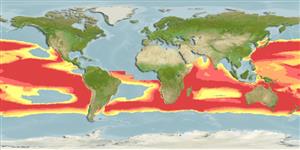分類 / Names
俗名 | 同種異名 | Catalog of Fishes(屬, 種) | ITIS | CoL | WoRMS | Cloffa
Teleostei >
Scombriformes (Mackerels)
鱸形目 (Mackerels) >
Bramidae (Pomfrets)
烏魴科 (Pomfrets)
Etymology: Pterycombus: Greek, pteron = wing, fin + Greek, kombos, oy = belt (Ref. 45335).
More on author: Hilgendorf.
Environment: milieu / climate zone / depth range / distribution range
生態學
海洋; 深度上下限 0 - 340 m (Ref. 58302). 溫帶
Southeast Atlantic. Indo-West Pacific: southwestern Africa to Japan and the central Pacific.
東南大西洋。 印度-西太平洋: 非洲西南方至日本與中太平洋。
大小 / 重量 / 年齡
Maturity: Lm ? range ? - ? cm
Max length : 36.4 cm SL 雄魚/尚未辨別雌雄; (Ref. 47377); common length : 31.0 cm TL 雄魚/尚未辨別雌雄; (Ref. 2272)
背棘 (總數) : 0; 背的軟條 (總數) : 46 - 55; 臀棘: 0; 臀鰭軟條: 37 - 40. Body color silvery-white, the membranes of the dorsal and anal fins black. Dorsal and anal fin very high, with scaly sheaths at its bases. No rays of the dorsal and anal fins thicker than their neighbors. Dorsal fin inserted above the posterior part of the eye. Attain 40 cm SL.
體色銀白色, 背鰭與臀鰭黑色的薄膜。 背鰭與臀鰭很高的, 與鱗鞘在它的基底。 比他們的鄰居厚的背鰭與臀鰭的沒有鰭條。 在眼的後面的部份上面的背鰭插入點。 達到 40 公分 SL 。
Juveniles probably found up to a depth of 200 m (Ref. 4388).
稚魚可能發現到深度 200 公尺。 (參考文獻 4388)
Life cycle and mating behavior
Maturities | 繁殖 | Spawnings | Egg(s) | Fecundities | 仔魚
東南大西洋。 印度-西太平洋: 非洲西南方至日本與中太平洋。
Gomes, J., 1990. Bramidae. p. 758-764. In J.C. Quero, J.C. Hureau, C. Karrer, A. Post and L. Saldanha (eds.) Check-list of the fishes of the eastern tropical Atlantic (CLOFETA). JNCT, Lisbon; SEI, Paris; and UNESCO, Paris. Vol. 2. (Ref. 4936)
人類使用
工具
特別的報告
下載 XML
網路資源
Estimates based on models
Preferred temperature (Ref.
123201): 13.5 - 27.8, mean 22.5 °C (based on 797 cells).
Phylogenetic diversity index (Ref.
82804): PD
50 = 0.7500 [Uniqueness, from 0.5 = low to 2.0 = high].
Bayesian length-weight: a=0.01820 (0.00782 - 0.04232), b=2.96 (2.76 - 3.16), in cm total length, based on LWR estimates for this (Sub)family-body shape (Ref.
93245).
營養階層 (Ref.
69278): 4.0 ±0.6 se; based on size and trophs of closest relatives
回復力 (Ref.
120179): 中等的, 族群倍增時間最少 1.4 - 4.4年 (Preliminary K or Fecundity.).
Fishing Vulnerability (Ref.
59153): Low to moderate vulnerability (34 of 100).
